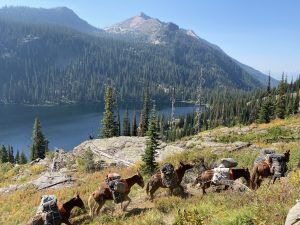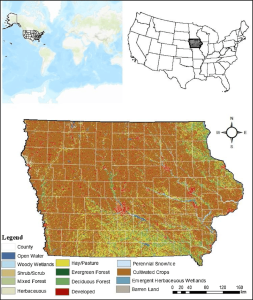59 Land Conservation
avewatson1
Introduction
Did you know that 75% of Earth’s land areas are severely deteriorated? According to National Geographic, a study published in 2018 found these harmed areas have either been cleared of forests, contaminated or have turned into deserts (Leahy, 2018). This is driven by various factors, such as increasing levels of agricultural expansion, deforestation, and urbanization. Every living thing depends on land for its survival – it serves as the foundation of our ecosystems, cultures, and economies. It’s intertwined with everything from preserving water quality to ensuring food security (Barrett, n.d.). Thus, it’s essential that we take steps to protect our lands. (AMW)
Land conservation refers to the process of protecting natural land to ensure preservation for future generations (Team, 2024). It’s a subtopic of conservation – a direct response to the harm we see being done across the planet (11 Reasons Why Protecting the Environment Is Important, 2023). There are many ways to ensure land quality, which are guided by environmental regulations. These regulations can take the shape of laws, policies, or rules designed to protect natural areas from degradation, overuse, and destruction. In this subsection, we’ll uncover these regulations on a national, local, and global scale. (AMW)
Land Regulations in the United States
In the United States, land is managed through federal, state, and private lands. All of these entities house their own environmental conservation efforts. But first, let’s look at federal efforts.
Historic Framework
To understand land conservation efforts, we first must look to the past. The history of protecting land starts with the popularization of conservation itself. In fact, the 26th president of the United States, Theodore Roosevelt, helped popularize the term (U.S. National Park Service, 2015). From 1901-1909, he set aside 230 million acres for bird reservations and national parks and forests. President Roosevelt saw conservation as a domestic priority and laid the foundation for land protected that expanded throughout the 1900’s. (AMW)
View the table below to see milestones in land conservation.
| 1872 | Yellowstone becomes the world’s first national park. |
| 1891 | The Forest Reserve Act is passed and gives the President authority to designate forest reserves, ensuring the protection of these areas. |
| 1905 | The U.S Forest Service is established and oversees national forests and promotes sustainable land use. |
| 1916 | The National Park Service was created to manage and protect national parks and historical sites. |
| 1935 | The Soil Conservation Service was passed in response to the Dust Bowl and educated landowners across the country about the benefits of conservation. |
| 1964 | Wilderness Act authorized congress to designate wilderness areas, managed by government agencies. |
| 1965 | Land and Water Conservation Fund designated oil and gas revenue to support state and federal conservation projects. |
| 1970 | Environmental Protection Agency was established to protect air, water, and land through regulation and policy. |
| 1985 | Conservation Reserve Program was enacted to pay farmers to take some of their land out of production to help the quality of soil and water. |
| 2009 | Omnibus Public Land Management Act began to protect more national parks, monuments, wilderness, and trails. |
| 2020 | Great American Outdoors Act provides permanent funding for the Land and Water Conservation Fund. |
(USDA, n.d.)
Key Government Players & Initiatives
There are many policies, acts, agencies, and laws that have been passed to conserve land. They exist to make sure that individuals and businesses alike are complying with environmental efforts. The section below will uncover the key agencies that play a role in protecting our land and the resources they provide in the United States.
U.S. Department of Agriculture (USDA)
The United States Department of Agriculture is an agency that provides resources and support for food, agriculture, natural resources, rural development, nutrition, and more. The USDA plays a key role in conserving land in the United States by recognizing that ensuring land preservation results in a healthy environment all-around. The USDA particularly focuses on farms, ranches and forests (USDA, 2025). Under this department, there are a multitude of environmental initiatives. In this chapter, we’ll cover the Agriculture Conservation Easement Program (ACEP) and more.
The Agriculture Conservation Easement Program (ACEP) is focused on protecting agricultural well-being and conservation of land. This program has two different focuses: Agricultural Land Easements, and Wetland Reserve Easements. Simply put, this program helps landowners protect, restore, and enhance land on farms and ranches (National Resource Conservation Service, n.d.). The ACEP program is known to be an effective resource, providing an incentive to landowners to preserve natural resources. (AMW)
Another land conservation effort under the USDA is the awarding of Conservation Innovation Grants (CIG) that financially help support new practices, technologies, and tools to aid in conservation efforts (Conservation Innovation Grants | Natural Resources Conservation Service, 2023). This is a competitive program that has many success stories, including the development of 3D technology to help farmers fight against weeds overtaking crops. Another example of a successful CIG grant is to combat predators on farmlands in the western part of the country (Conservation Innovation Grant Helps Landowners Reduce Conflicts between Predators, Working Lands | Natural Resources Conservation Service, 2024). Finally, the USDA also oversees The Healthy Forests Reserve Program (HFRP). Through HFRP, the USDA provides landowners with 10-year restoration agreements (USDA, 2025). (AMW)
U.S. Environmental Protection Agency (EPA)
The Environmental Protection Agency is a federal agency with the mission to protect the environment and human well-being (EPA, 2013). Although they are focused more on air and water quality than land, air and land directly affect land quality. The Environmental Protection Agency (EPA) houses:
- The Clean Air Act: If there was a list of notable regulations, The Clean Air act is certainly at the top (Farber, 2024). This act was first enacted in 1963 and allows the Environmental Protection Agency (EPA) to establish National Ambient Air Quality Standards (NAAQS). This helps regulate emissions of hazardous air pollutants like Biphenyl and Asbestos. Not only that, but it has provided a basis for EPA regulation of Greenhouse Gases.
- The Clean Water Act: provides a basis for the regulation of pollutants into the waters of the United States and regulating water quality standards for surface waters. The basic act was enacted in 1948 but was significantly changed in 1972. The CWA sets wastewater standards for industry.
- The Safe Drinking Water Act: Ensures safe drinking water for individuals across the country.
- The Resource Conservation and Recovery Act: Governs the disposal of solid and hazardous waste.
U.S. Department of the Interior (DOI)
The DOI is responsible for managing and conserving federal lands and natural resources. This federal department oversees over 400 million acres of federal lands. They implement regulations and responsibilities through their various bureaus (U.S. Department of the Interior, 2015). The bureaus consist of the following: Bureau of Indian Affairs, Bureau of Indian Education, Bureau of Land Management, Bureau of Ocean Energy Management, Bureau Reclamation, Bureau of Safety and Environmental Enforcement, National Park Service, Office of Surface Mining Reclamation and Enforcement, U.S. Fish and Wildlife Service, and the U.S. Geological Survey. Although some of these bureaus don’t seem to directly influence land conservation, they all play some key roles. (AMW)
The bureau’s most concerned with land preservation are the National Park Service, Office of Surface Mining Reclamation and Enforcement, and the U.S. Geological Survey. The National Park Service oversees the federally looked after national parks like Yellowstone and Yosemite. This entity preserves the state of national parks for all to enjoy. Without it, our national parks would look a lot different. They wouldn’t be in the same state they are today, as the National Park service regulates and manages these parks. The Office of Surface Mining Reclamation and Enforcement restores the environment through the regulation of coal mines (U.S. Department of the Interior, 2015). Without this regulation, there would be harmful effects on the environment such as the destruction of habitats. (AMW)
Key Environmental Regulations
There are many acts that have directly influenced land quality and conservation efforts. Such as the Clean Water Act (CWA), Clean Air Act (CAA), and more. However, I will overview the main regulations that focus on maintaining land quality.
National Environmental Policy Act (NEPA)
The United States has several environmental regulations that seek to protect our land. NEPA, the National Environmental Policy Act, as mentioned in the timeline above, has been both influential and controversial. Signed in 1970, NEPA requires federal agencies to sign off on different projects, ensuring that the project proposed does not extensively harm the environment (EPA, 2013). NEPA highlights the importance of public participation and environmental justice. It requires government officials to consider environmental harm, and stop it where needed. Under NEPA, the federal government must release environmental impact statements (EISs) for the public to view and be able to comment on (Pepper, 2015). EIS’s are released in multiple drafts as more commentary comes in from the public. However, the effectiveness of NEPA is questioned when it comes to timelines. In fact, the review process can take from 2-10 years (Author, n.d.). Criticisms also come about when noting that officials must consider environmental harm, but that doesn’t mean that they must do something about it. In all, NEPA has both positives and negatives. Nevertheless, it has served an incredibly important role in protecting our nation’s land. There are a multitude of successful environmental initiatives that come from this act, discussed farther along in this section. (AMW)
Endangered Species Act (ESA)
The Endangered Species Act (ESA), established in 1973, provides resources for helping threatened species and the habitats in which they live (U.S. Fish & Wildlife Service, 1973). ESA does a variety of things, including:
- Requiring permits to hunt and/or kill animals
- Lists species as Endangered or Threatened
- Protects habitats in bad conditions
- Develops recovery plans to help species
The ESA’s primary goal is to prevent extinction, something they have notably succeeded in. In fact, 99% of species listed under it have avoided extinction. There are some criticisms, such as the amount of time species are listed, which usually spans decades (Cosier, 2015). In all, this act is important to land protection, as it has helped biodiversity, and habitat preservation, having a resounding positive effect on land conservation efforts. (AMW)
The Wilderness Act


The Wilderness Act, established in 1964, allows congress to designate wilderness areas. This act preserves areas in their most natural state (Wilderness Act of 1964 | U.S. Fish & Wildlife Service, n.d.). Thus, no roads, no permanent structures, and little to no motorized vehicles are allowed on these lands. However, individuals can hike, horseback ride, and camp on these lands. Some examples of areas protected under The Wilderness Act are Bob Marshall Wilderness, Montana and the Gila Wilderness in New Mexico. This act has been incredibly important to land conservation as there are incredibly strict regulations when using this land, ensuring that it is preserved in its natural state. (AMW)
The Federal Land Policy and Management Act
The Federal Land Policy and Management Act was established in 1976. This cornerstone land legislation was important especially for lands managed by the Bureau of Land Management (BLM). The Bureau of Land Managment is an entity within the Department of Interior, and responsible for sustaining the health and productivity of public lands. This act creates rules center to conservation (Bureau of Land Management, 2016). It mandates that BLM develop Resource Management Plans for every area under its scope. This directly affects land conservation as BLM can halt activities that harm land as it sees fit. For example, mining operations and off-road vehicle use in areas of critical condition.
Resource Conservation and Recovery Act
The Resource Conservation and Recovery Act, established in 1973, governs the control and disposal of waste. This is important in conserving land as it protects land from pollution (EPA,2018). Pollution directly affects our lands, when land is polluted, the soil can become contaminated, affecting our food supply. By promoting sustainable waste management practices, it ensures that waste is disposed of properly, and that contaminated sites are managed. (AMW)
United States Success Stories
The Endangered Species Act is largely successful. Here is some success stories concerned with this act. If we took a time machine back to the 1960’s, we wouldn’t see many bald eagles. In fact, only about 500 existed some 60 years ago (Endangered Species: 6 Stories of Success, n.d.). This dangerous number was due to harmful pesticides and chemical use. The Endangered Species act restored the bald eagle population to over 13,000 in the United States today. Interventions like breeding programs, habitat protection, and a ban on dangerous chemicals can be thanked. Due to the formation of the National Park Service, The Everglades, Florida, has been preserved after 100 years of conservation efforts. Theodore Roosevelt National Park is another example of a National Park Success, housed within the North Dakota Badlands. (AMW)
As mentioned above, implementation of NEPA is a considerable landmark for environmental regulation and practice. It highlights the importance of public forum and allows for the halting of damaging projects. For example, NEPA halted the establishment of the Tocks Island Dam in 1975 (Bushkill & Us, n.d.). The dam would’ve costed not just a lot of money but would have negatively affected the environment as well. On the flip side, highway improvements in Montana came with wildlife crossings after the NEPA process received input from communities concerned about wildlife (Pepper, 2015). (AMW)
The State of Iowa
Historic Framework

Iowa was once covered in forests and home to Native American Tribes, who held land stewardship center to their lives (Kiffel-Alcheh, 2015). This all changed in the 1830’s, when European settlers came to Iowa. But the arrival of these settlers led to a major shift in landscape. Farming and logging activities led to a large number of forests being lost- resulting to biodiversity loss and soil erosion. Although long ago, these changes in landscape inspired the shaping of the conservation movement in Iowa in the late 1800s and early 1900s. (AMW)
That, coupled with President Theodore Roosevelt spearheading the conservation movement in the United States, the Iowa Conservation Commission was established in 1917 (RG 084 Soil Conservation, 2024). This committee promoted wildlife conservation and oversaw state parks, marking the beginning of structured conservation efforts. In the 1930s, The Dust Bowl led to a federal push for soil conservation. And in 1935, The Soil Conservation Act passed by congress. This led to the establishment of soil conservation districts (CDI) in Iowa. In 1939, the State Soil Conservation Committee was established to serve as an agency of the state. Later in the 1900s, conservation programs expanded more and more. One notable program was the Iowa Conservation Reserve Program (CRP), introduced in the 80’s as a national initiative (Iowa Conservation Reserve Enhancement Program (CREP) | Iowa Department of Agriculture and Land Stewardship, n.d.). This program provides incentives to landowners who voluntarily establish wetlands for water quality improvement. The goal of this program is to improve water quality, and it is still around today. (AMW)
Modern Initiatives
That leads us into modern conservation initiatives taking place in Iowa today. The Iowa Department of Natural Resources (DNR) is a key player in land conservation. The DNR manages over 4,000 acres of public land, and oversees parks, wildlife areas, and state forests. The DNR’s goal is to preserve Iowa’s natural landscapes, as Iowa is one of the most agriculturally productive states in the U.S. With miles and miles of farmland growing corn and soybeans, it’s more important than ever to keep soil healthy and away from degradation and erosion. The Iowa DNR has many modern programs. Since 1990, the DNR has hosted Pollution Prevention (P2) Services (Pollution Prevention Services, 2025). This program is focused on source reduction and can be practiced by implementing conservation techniques and reusing materials rather than putting them in a waste stream. For example, reusing incoming packaging for outgoing packaging. This is used by businesses and results in not only conservation efforts, but also company savings and enhances employee safety. The P2 program is also focused on recycling, to minimize the waste generated. Over time, this program has grown in popularity and is utilized by many businesses across the state of Iowa (Iowa DNR, 2025). The DNR also manages the Land Recycling Program (LRP). This program assesses the contamination issues of a property, then the DNR establishes implementation of initiatives to appropriately cleanup the property at hand. The DNR also seeks to educate individuals throughout the state through their mobile education unit, raising awareness for the importance of maintaining land. (AMW)
Techniques like conservation tillage, cover crops, and nutrient management are increasingly being used to prevent soil degradation. Iowa also faces another problem when it comes to agriculture. Issues with water quality are a common occurrence across the state. To help combat this, the Iowa Nutrient Reduction Strategy was launched in 2013 (Iowa Nutrient Reduction Strategy | Iowa Nutrient Reduction Strategy, n.d.). The strategy promotes voluntary measures to reduce runoff from agricultural lands. The Iowa Watershed Approach is focused on improving water quality through conservation efforts. The Iowa Tallgrass Prairie Restoration is another important initiative. Public and private entities across the state have collaborated to bring back native grasses and species. (AMW)
Global Approaches
Across the globe, multiple nations are concerned about the state of our lands. Conservation is a hot topic many country leaders focus on. We all live on the same planet, share many of the same resources, and all, in some way, contribute to the environmental problems Earth is facing.
United Nations Initiatives
The Paris Agreement is a landmark international treaty on climate change (UNFCCC, 2024). It was adopted at the UN Climate Change Conference on December 12th, 2015. The agreement seeks to hold the global surface temperature to well below 2 degrees Celsius. The lower the temperature increases, the less the effects of climate change. Under the treaty, each country participating must plan and regularly report on its contributions. The main challenge associated with The Paris Agreement, like many other international agreements, is enforcement. Although the agreement requires monitoring of carbon emissions, it can’t force a country to reduce emissions. The United States was a key player of The Paris Agreement under President Barack Obama. However, the United States has withdrawn from The Paris Agreement, both times under President Donald Trump (Nahm, 2023). (AMW)
The United Nations (UN) also has several programs aimed at preserving land. Under the Sustainable Development Goals (SDGs), Goal 15: Life on Land focuses on aiding land conservation ((United Nations, n.d.). Broken down, this goal focuses on putting a stop to deforestation, combating the desertification of lands, restoring degraded soil, and protecting natural habitats and biodiversity. Through this goal the United Nations collaborates on what works best for sustaining land and compares notes on what works and doesn’t. The UN also houses the UN Convention to Combat Desertification (Convention, n.d.). This is a legally binding international agreement that helps mitigate desertification and the effects of droughts through action programs and strategies. It requires partnership and collaboration between nations to effectively take on environmental challenges. (AMW)
Although these are just a few examples of the environmental regulations and initiatives through the UN, the United Nations plays an important role in shaping global land conservation efforts. Through policy and governance, funding and support, training, tools and education, and reporting information, they serve as a key and important player in steps to protect our land throughout the world. (AMW)
Major Global Efforts
Outside of the United Nations, there are other major global efforts focused on land preservation. One of these efforts is the 30×30 initiative, which is a global commitment backed by over 190 countries (The Nature Conservancy, n.d.). This agreement is a commitment to ensure the preservation of 30% of Earth’s lands and oceans by the year 2030. The 30×30 initiative adopts the Kunming-Montreal Global Biodiversity Framework, which includes over 20 targets aimed at protecting habitat and species loss, directly impacting land preservation. While the success of this initiative is yet to be seen, as it is in its early stages, it’s still a big step towards global conservation efforts. (AMW)

In Costa Rica, Payments for Environmental Services (PES) is a widely successful environmental regulation. The program, which is like the United States Conservation Reserve Program, incentivizes conservation through payments to farmers (UNCC, 2025). The PES program has led to the conservation of over 1 million hectares of land and benefitted over 18,000 families. (AMW)
On the other hand, Australia’s National Environmental Law (EPBC Act), provides legal framework for conservation efforts (Pacey, 2021). However, a recent review found the law was ineffective and needs a lot of reform. The Australian Government is committed to bettering the EPBC, showing a real initiative. (AMW)
In Europe, the health of soil has come into focus as 61% is unhealthy (Soil Strategy for 2030, 2025). Thus, recent environmental efforts have focused on soil. The EU soil strategy is focused on sustaining food production, biodiversity, and climate resilience for the year 2030. The plan includes a new Soil Monitoring Law and more to strengthen European soil. Although relatively newer, this program has a fortunate outlook on its future. (AMW)
The global efforts discussed above showcase the diverse approaches to preserving our land. While challenges remain, such as a lack of funding and political opposition, these initiatives show us a growing commitment to preserving our lands. (AMW)
Challenges in Environmental Regulation
In this chapter, we explored the environmental regulations that shape land conservation efforts in Iowa, the United States, and beyond. The United States has a commendable history of environmental regulation concerning land. However, as global climate change worsens and the scale of environmental issues grows, so does the need for funding the programs that help keep our land healthy. Recently, the Trump administration cut funding for multiple environmental agencies (Weixel, 2025). The federal government’s cutting of federal environmental programs has caused a stir. What is the future of these programs? It’s unpredictable. Often, regulations concerning the environment face political opposition. This is especially clear in the United States of America with the Trump Administration. It’s particularly interesting as the U.S has a commendable history of environmental regulations concerning land conservation. Other challenges in environmental land regulation include lack of enforcement, complex issues, and global coordination. (AMW)
Future Outlook
By 2050, 95% of the Earth’s land areas could become degraded due to the impact of our choices on the environment (Leahy, 2018). Environmental land regulations aim to minimize degradation and enhance land protection across the globe. Despite the existence of useful policies, acts, and initiatives, there is still more work to be done. With global warming increasing every year, there continues to be a need for evaluation of our impacts on the planet. Not just our land- but air, water, and other natural resources need conservation efforts. (AMW)

In order to help our planet and our future, we all need to work together. Environmental regulations play a vital role in protecting our landscapes -but what can we, as individuals, do? Well, have you ever recycled? Chosen public transportation over driving? Unplugged appliances to save energy? You might not know it, but these small actions make you part of the conservation movement, working to conserve and protect Earth’s natural resources (Team, 2024). Conservation is all about sustaining the world around us, and even small changes can have a positive impact. (AMW)
Key principles that guide conservation efforts include:
- Sustainability is about managing the use of a resource, so they are not depleted for future generations.
- Preservation of Biodiversity refers to keeping ecosystems healthy and operating normally. Conservation efforts are focused on protecting species and genetic diversity. When biodiversity lessons, ecosystems weaken, affecting supporting services like pollination, water purification, and more.
- Responsible Resource Management is focused on managing resources with the future in mind. For example, using solar energy instead of regular energy. Solar energy is better for the environment.
- Mitigation of Human Impact involves promoting sustainable agriculture and supporting policies that help protect the environment. This goes hand in hand with acknowledging the anthropogenic nature of many environmental problems.
- Restoration has to do with assisting in the recovery of destroyed or degraded ecosystems.
On an individual level, we may not be able to achieve each of these principles. That’s why local, state, national, and global regulations exist to help conserve our world. By using these principles, we can work together to create a healthier planet. To learn more about how you can make an impact, visit: https://populationeducation.org/how-to-make-conservation-more-inclusive-take-these-six-actions/.
